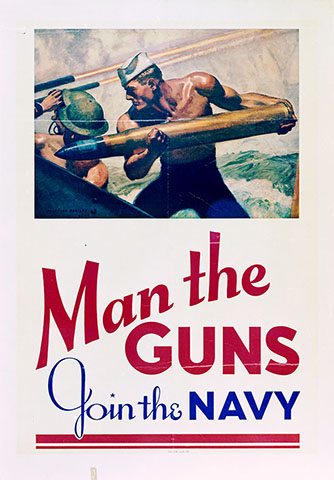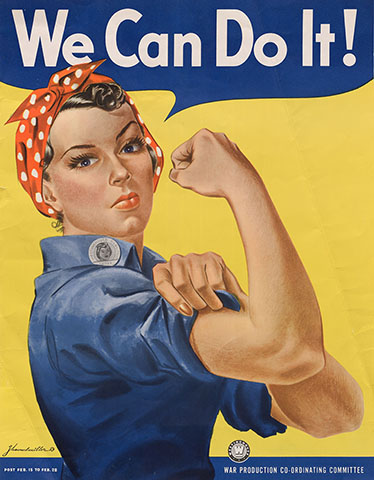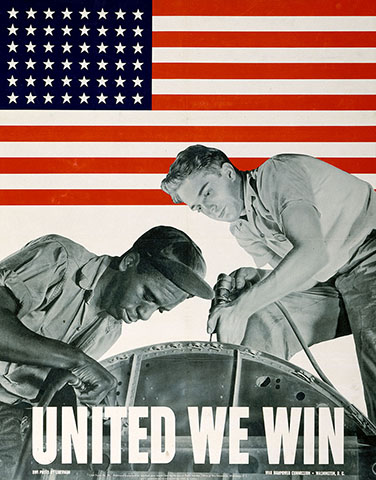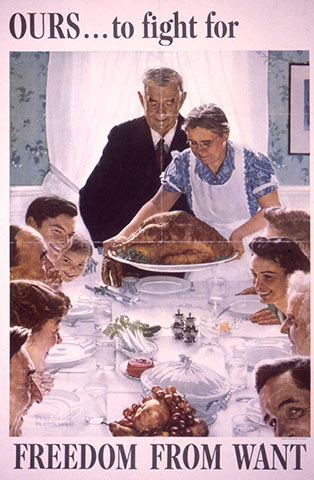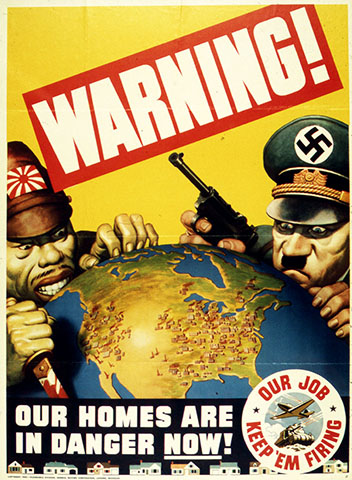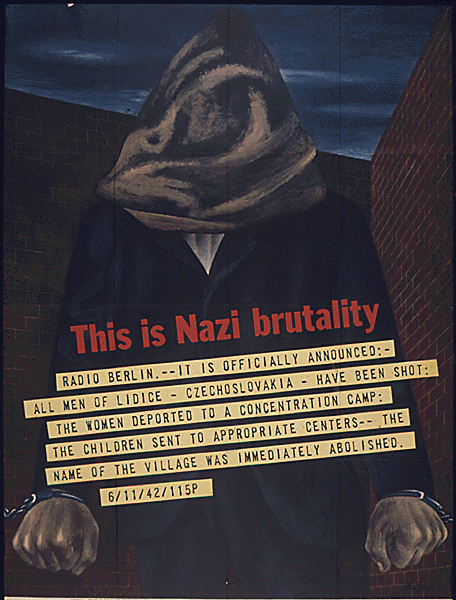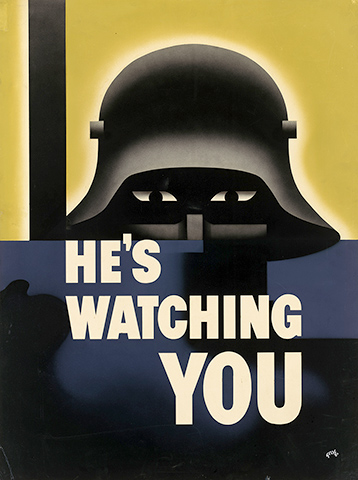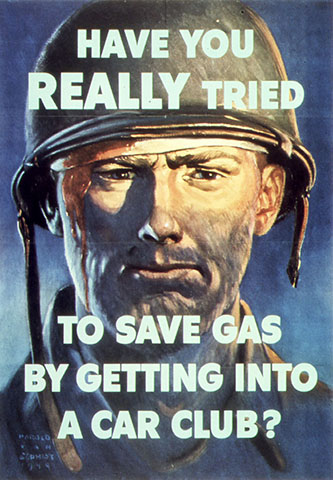
Powers of Persuasion
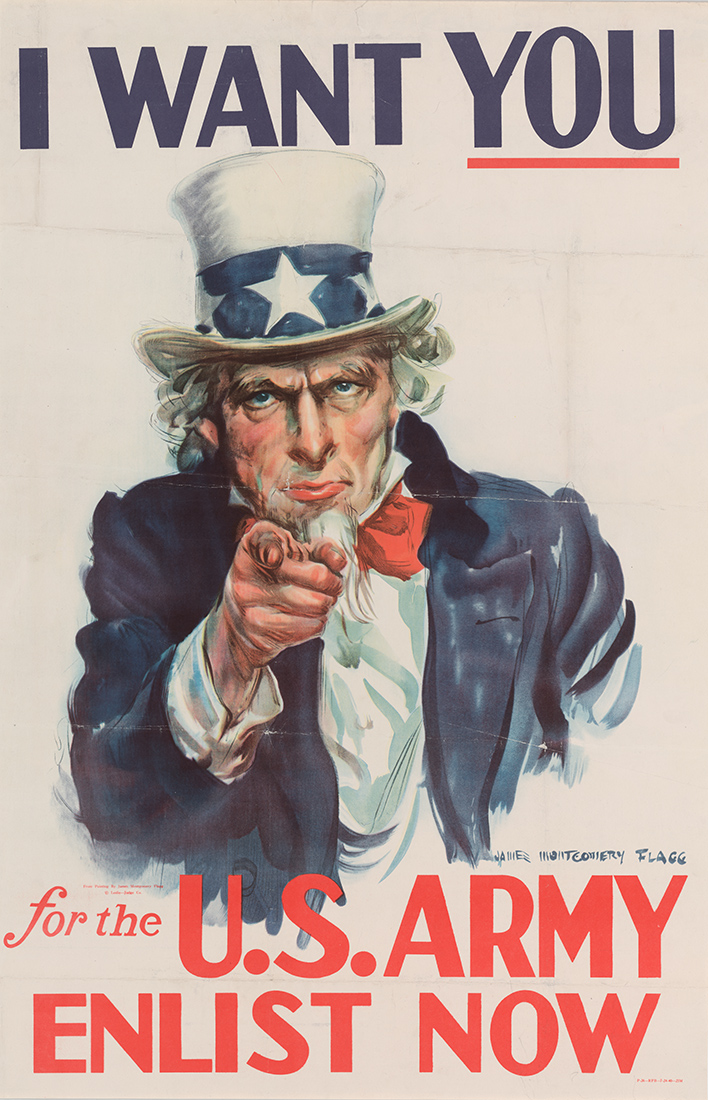
"I Want You"
by James Montgomery Flagg, 1940. National Archives, Army Recruiting Bureau
Guns, tanks, and bombs were the principal weapons of World War II, but there were other, more subtle forms of warfare as well. Words, posters, and films waged a constant battle for the hearts and minds of the American citizenry just as surely as military weapons engaged the enemy. Persuading the American public became a wartime industry, almost as important as the manufacturing of bullets and planes. The Government launched an aggressive propaganda campaign with clearly articulated goals and strategies to galvanize public support, and it recruited some of the nation's foremost intellectuals, artists, and filmmakers to wage the war on that front.
Posters are the focus of this online exhibit, based on a more extensive exhibit that was presented in the National Archives Building in Washington, DC, from May 1994 to February 1995. It explores the strategies of persuasion as evidenced in the form and content of World War II posters. Quotes from official manuals and public leaders articulate how the Government sought to rally public opinion in support of the war's aims; quotes from popular songs and sayings attest to the success of the campaign that helped to sustain the war effort throughout the world-shaking events of World War II.
Jump to Part 1 Galleries:
Jump to Part 2 Galleries:
Part 1: Patriotic Pride
Man the Guns!
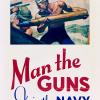
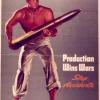

Man the Guns—Join the Navy, by McClelland Barclay, 1942, Records of the Office of Government Reports View in Online Catalog
(NAID: 513519)
Keep 'em fighting. Production wins wars. Stop accidents, Printed for the National Safety Council, Inc., Records of the Office of Government Reports View in Online Catalog
(NAID: 514767)
Get hot—keep moving. Don't waste a precious minute., Records of War Production Board View in Online Gallery
(NAID: 535107)
Masculine strength was a common visual theme in patriotic posters. Pictures of powerful men and mighty machines illustrated America's ability to channel its formidable strength into the war effort. American muscle was presented in a proud display of national confidence.
Accentuate the Positive, Eliminate the Negative, Latch on to the Affirmative, Don't Mess with Mr. In-Between.
It's a Woman's War Too!
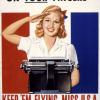


Victory Waits On Your Fingers—Keep 'Em Flying Miss U.S.A., Produced by the Royal Typewriter Company for the U.S. Civil Service Commission, Records of the Office of Government Reports View in Online Catalog
(NAID: 515979)
Longing Won't Bring Him Back Sooner...Get a War Job!, by Lawrence Wilbur, 1944, Records of the Office of Government Reports View in Online Catalog
(NAID: 513840)
We Can Do It!, by J. Howard Miller, Produced by Westinghouse for the War Production Co-Ordinating Committee, Records of the War Production Board View in Online Catalog
Of all the images of working women during World War II, the image of women in factories predominates. Rosie the Riveter—the strong, competent woman dressed in overalls and bandanna—was introduced as a symbol of patriotic womanhood. The accoutrements of war work—uniforms, tools, and lunch pails—were incorporated into the revised image of the feminine ideal.
(NAID: 535413)
In the face of acute wartime labor shortages, women were needed in the defense industries, the civilian service, and even the Armed Forces. Despite the continuing 20th century trend of women entering the workforce, publicity campaigns were aimed at those women who had never before held jobs. Poster and film images glorified and glamorized the roles of working women and suggested that a woman's femininity need not be sacrificed. Whether fulfilling their duty in the home, factory, office, or military, women were portrayed as attractive, confident, and resolved to do their part to win the war.
These jobs will have to be glorified as a patriotic war service if American women are to be persuaded to take them and stick to them. Their importance to a nation engaged in total war must be convincingly presented.
United We Win
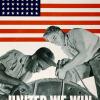
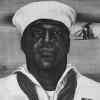
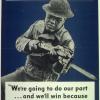
United We Win, Photograph by Alexander Liberman, 1943, Printed by the Government, Printing Office for the War Manpower Commission, Records of the Office of Government Reports View in Online Catalog
(NAID: 513820)
Above and Beyondthe Call of Duty, by David Stone Martin, Printed by the Government, Printing Office for the Office of War Information, Records of the Office of War Information View in Online Catalog
At the beginning of the war, African Americans could join the Navy but could serve only as messmen. Doris ("Dorie") Miller joined the Navy and was in service on board the USS West Virginia during the attack on Pearl Harbor. Restricted to the position of messman, he received no gunnery training. But during the attack, at great personal risk, he manned the weapon of a fallen gunman and succeeded in hitting Japanese planes. He was awarded the Navy Cross, but only after persistent pressure from the black press.
(NAID: 535886)
Pvt. Joe Louis Says—We,re Going to do our part . . . and we'll win because we're on God's side, Records of the Office Government Reports View in Online Catalog
(NAID: 513548)
During World War II, racial restriction and segregation were facts of life in the U.S. military. Nevertheless, an overwhelming majority of African Americans participated wholeheartedly in the fight against the Axis powers. They did so, however, with an eye toward ending racial discrimination in American society. This objective was expressed in the call, initiated in the black press for the "Double V"—victory over fascism abroad and over racism at home. The Government was well aware of the demoralizing effects of racial prejudice on the American population and its impact on the war effort. Consequently, it promoted posters, pamphlets, and films highlighting the participation and achievement of African Americans in military and civilian life.
We say glibly that in the United States of America all men are free and equal, but do we treat them as if they were? . . . There is religious and racial prejudice everywhere in the land, and if there is a greater obstacle anywhere to the attainment of the teamwork we must have, no one knows what it is.
Use it Up, Wear it Out


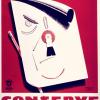
When You Ride Alone You ride with Hilter!, by Weimer Pursell, 1943, Records of the Office of Government Reports View in Online Catalog
(NAID: 516143)
Save Waste Fats for Explosives, by Henry Koerner, 1943, Records of the Office of Government Reports View in Online Catalog
(NAID: 513832)
Waste Helps the Enemy, by Vanderlaan, Records of the War Production Board View in Online Catalog
(NAID: 533960)
During the war years, gasoline, rubber, sugar, butter, and meat were rationed. Government publicity reminded people that shortages of these materials occurred because they were going to the troops, and that civilians should take part in conservation and salvage campaigns.
Astronomical quantities of everything and to hell with civilian needs.
Four Freedoms
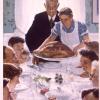
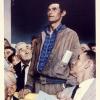
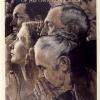
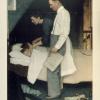
Ours...to fight for—Freedom From Want, by Norman Rockwell, ©1943 SEPS: The Curtis Publishing Co., Agent
Printed by the Government Printing Office for the Office of War Information, Records of the Office of Government Reports View in Online Catalog
(NAID: 513710)
Save Freedom of Speech, by Norman Rockwell, ©1943 SEPS: The Curtis Publishing Co., Agent, Printed by the Government Printing Office for the Office of War Information, Records of the Office of Government Reports View in Online Catalog
(NAID: 513711)
Save Freedom of Worship, by Norman Rockwell, ©1943 SEPS: The Curtis Publishing Co., Agent, Printed by the Government Printing Office for the Office of War Information, Records of the Office of Government Reports View in Online Catalog
(NAID: 513712)
Ours...to fight for—Freedom From Fear, by Norman Rockwell, ©1943 SEPS: The Curtis Publishing Co., Agent, Printed by the Government Printing Office for the Office of War Information, Records of the Office of Government Reports View in Online Catalog
(NAID: 513666)
President Roosevelt was a gifted communicator. On January 6, 1941, he addressed Congress, delivering the historic "Four Freedoms" speech. At a time when Western Europe lay under Nazi domination, Roosevelt presented a vision in which the American ideals of individual liberties were extended throughout the world. Alerting Congress and the nation to the necessity of war, Roosevelt articulated the ideological aims of the conflict. Eloquently, he appealed to Americans' most profound beliefs about freedom. The speech so inspired illustrator Norman Rockwell that he created a series of paintings on the "Four Freedoms" theme. In the series, he translated abstract concepts of freedom into four scenes of everyday American life. Although the Government initially rejected Rockwell's offer to create paintings on the "Four Freedoms" theme, the images were publicly circulated when The Saturday Evening Post, one of the nation's most popular magazines, commissioned and reproduced the paintings. After winning public approval, the paintings served as the centerpiece of a massive U.S. war bond drive and were put into service to help explain the war's aims.
We look forward to a world founded upon four essential human freedoms. The first is freedom of speech and expression—everywhere in the world. The second is freedom of every person to worship God in his own way—everywhere in the world. The third is freedom from want . . . everywhere in the world. The fourth is freedom from fear . . . anywhere in the world.
Part 2: Staying Vigilant
Warning!
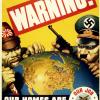
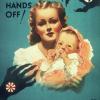
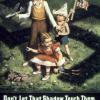
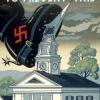
WARNING! Our Homes Are in Danger Now!, produced by the General Motors Corporation, 1942, Records of the Office of Government Reports View in Online Catalog
(NAID: 516040)
Keep These Hands Off!, by G. K. Odell, Records of the Office of Government Reports View in Online Catalog
A study of commercial posters undertaken by the U.S. Government found that images of women and children in danger were effective emotional devices. The Canadian poster at right was part of the study and served as a model for American posters, such as the one below, that adopted a similar visual theme.
(NAID: 513550)
Don't Let That Shadow Touch Them. Buy War Bonds., by Lawrence B. Smith, 1942, Produced for the Government Printing Office for the U.S. Treasury, Records of the Office of Government Reports View in Online Catalog
(NAID: 513572)
We're Fighting to Prevent This, by C. R. Miller, Think America Institute, Kelly Read & Co., Records of the Office of Government Reports View in Online Catalog
(NAID: 516102)
Public relations specialists advised the U.S. Government that the most effective war posters were the ones that appealed to the emotions. The posters shown here played on the public's fear of the enemy. The images depict Americans in imminent danger-their backs against the wall, living in the shadow of Axis domination.
Commercial advertising usually takes the positive note in normal times . . . But these are not normal times; this is not even a normal war; it's hell's ideal of human catastrophy [sic], so menace and fear motives are a definite part of publicity programs, including the visual.
This is Nazi Brutality
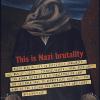
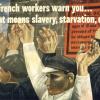

This is Nazi Brutality, by Ben Shahn, 1942, Printed by the Government Printing Office for the Office of War Information, Records of the Office Government Reports View in Online Catalog
Lidice was a Czech mining village that was obliterated by the Nazis in retaliation for the 1942 shooting of a Nazi official by two Czechs. All men of the village were killed in a 10-hour massacre; the women and children were sent to concentration camps. The destruction of Lidice became a symbol for the brutality of Nazi occupation during World War II.
(NAID: 513687)
We French Workers Warn You...Defeat Means Slavery, Starvation and Death., By Ben Shahn, 1942, Printed by the Government Printing Office for the War Information Board, Records of the Office of Government Reports View in Online Catalog
(NAID: 513688)
The Sowers, by Thomas Hart Benton, 1942, Records of the Office of Government Reports View in Online Catalog
Artist Thomas Hart Benton believed that it was the artist's role either to fight or to "bring the bloody actual realities of this war home to the American people." In a series of eight paintings, Benton portrayed the violence and barbarity of fascism. "The Sowers" shows the enemy as bulky, brutish monsters tossing human skulls onto the ground.
(NAID: 515648)
Many of the fear-inspiring posters depicted Nazi acts of atrocity. Although brutality is always part of war, the atrocities of World War II were so terrible, and of such magnitude, as to engender a new category of crime—crimes against humanity. The images here were composed to foster fear. Implicit in these posters is the idea that what happened there could happen here.
Under their system, the individual is a cog in a military machine, a cipher in an economic despotism; the individual is a slave. These facts are documented in the degradation and suffering of the conquered countries, whose fate is shared equally by the willing satellites and the misguided appeasers of the Axis.
He's Watching You
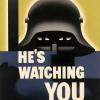

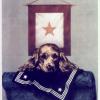

He's Watching You, by Glenn Grohe, ca. 1942, Gouache on cardboard, Records of the Office of War Information View in Online Catalog
(NAID: 7387549)
Someone Talked!, by Siebel, 1942, Printed by the Government Printing Office for the Office of War Information, Records of the Office of War Information View in Online Catalog
(NAID: 513672)
...Because Somebody Talked!, By Wesley, 1943, Printed by the Government Printing Office for the Office of War Information, Records of the Office of Government Reports View in Online Catalog
(NAID: 513669)
Wanted! For Murder, by Victor Keppler, 1944, Records of the Office of Government Reports View in Online Catalog
A woman—someone who could resemble the viewer`s neighbor, sister, wife, or daughter—was shown on a "wanted" poster as an unwitting murderess.
At least one viewer voiced objection to the choice of a female model. A letter from a resident of Hawaii to the Office of War Information reads, in part, "American women who are knitting, rolling bandages, working long hours at war jobs and then carrying on with 'women's work' at home—in short, taking over the countless drab duties to which no salary and no glory are attached, resent these unwarranted and presumptuous accusations which have no basis in fact, but from the time-worn gags of newspaper funny men."
(NAID: 513599)
Concerns about national security intensify in wartime. During World War II, the Government alerted citizens to the presence of enemy spies and saboteurs lurking just below the surface of American society. "Careless talk" posters warned people that small snippets of information regarding troop movements or other logistical details would be useful to the enemy. Well-meaning citizens could easily compromise national security and soldiers' safety with careless talk.
Words are ammunition. Each word an American utters either helps or hurts the war effort. He must stop rumors. He must challenge the cynic and the appeaser. He must not speak recklessly. He must remember that the enemy is listening.
Meaning of Sacrifice
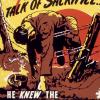
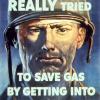
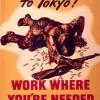
You Talk of Sacrifice..., Produced by Winchester, Records of the War Production Board View in Online Catalog
(NAID: 535236)
Have You Really Tried to Save Gas by Getting Into a Car Club?, By Harold Von Schmidt, 1944, Printed by the Government Printing Office, Records of the Office of Government Reports View in Online Catalog
(NAID: 513630)
Miles of Hell to Tokyo!, By Amos Sewell, 1945, Printed by the Government Printing Office for the War Manpower Commission, Records of the Office of Government Reports View in Online Catalog
(NAID: 515009)
To guard against complacency, the Government promoted messages that reminded civilian America of the suffering and sacrifices that were being made by its Armed Forces overseas.
The mortal realities of war must be impressed vividly on every citizen. There is a lighter side to the war picture, particularly among Americans, who are irrepressibly cheerful and optimistic. But war means death. It means suffering and sorrow. The men in the service are given no illusions as to the grimness of the business in which they are engaged. We owe it to them to rid ourselves of any false notions we may have about the nature of war.
Stamp 'Em Out
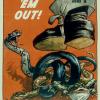
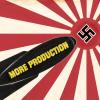
Stamp `Em Out!, Produced by RCA Manufacturing Company, Inc., Records of the Office of Government Reports View in Online Catalog
(NAID: 515473)
More Production, by Zudor, Printed by the Government Printing Office for the War Production Board, Records of the Office of War Information View in Online Catalog
(NAID: 7387556)
The Government tried to identify the most effective poster style. One government-commissioned study concluded that the best posters were those that made a direct, emotional appeal and presented realistic pictures in photographic detail. The study found that symbolic or humorous posters attracted less attention, made a less favorable impression, and did not inspire enthusiasm. Nevertheless, many symbolic and humorous posters were judged to be outstanding in national poster competitions during the war.
War posters that are symbolic do not attract a great deal of attention, and they fail to arouse enthusiasm. Often, they are misunderstood by those who see them.
Additional Media
Song: "Any Bonds Today?"
Transcript:
"Any bonds today?
Bonds of freedom
That's what I'm selling
Any bonds today?
Scrape up the most you can
Here comes the freedom man
Asking you to buy a share of freedom today
Any stamps today?
We'll be blest
If we all invest
In the U.S.A.
Here comes the freedom man
Can't make tomorrow's plan
Not unless you buy a share of freedom today"
Speech: President Roosevelt's Address
Transcript: Excerpt from President Franklin D. Roosevelt's Message to Congress on January 6, 1941
"The first is the freedom of speech and expression—everywhere in the world. The second is the freedom of every person to worship God in his own way—everywhere in the world. The third is freedom from want—which, translated into world terms, means economic understandings which will secure to every nation a healthy peacetime life for its inhabitants—everywhere in the world. The fourth is freedom from fear—which, translated into world terms, means a world-wide reduction of armaments to such a point and in such a thorough fashion that no nation will be in a position to commit an act of physical aggression against any neighbor—anywhere in the world." (applause)
Video: Bugs Bunny
